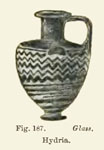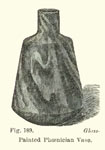Previous First Next
SALAMIS IN THE ISLAND OF CYPRUS.
BY ALEXANDER PALMA DI CESNOLÀ, F.S.A.,
page 89
used by them for these objects. In the example before us, the method of laying on the light-coloured pattern is clearly  shown. Beginning at the lowest part of the body, the artistic operator appears to have shown. Beginning at the lowest part of the body, the artistic operator appears to have laid on a liquid or vitreous slip from a receptacle with an orifice, or, perhaps, a fine rod of glass, heated to a temperature sufficiently high to make it pliable and adhesive. Taking a rapid spiral turn, he reached the wide part of the body, and there commenced a zigzag, which at the first was irregular, but gradually attained accuracy of dimensions. On reaching the upper limit of the body, the zigzag fades away into a few circular lines, and a rapid near the lip as spiral brings the embellishment to a close Perhaps the coloured surfaces were rolled afterwards while still hot, so to impress the pattern into the dark body-ground of the glass. Fig. 187 is another hydria, not so upright in its contour, but equally remarkable as a work of art, and equally representative of the Phœnician art-manufacture. One laid on a liquid or vitreous slip from a receptacle with an orifice, or, perhaps, a fine rod of glass, heated to a temperature sufficiently high to make it pliable and adhesive. Taking a rapid spiral turn, he reached the wide part of the body, and there commenced a zigzag, which at the first was irregular, but gradually attained accuracy of dimensions. On reaching the upper limit of the body, the zigzag fades away into a few circular lines, and a rapid near the lip as spiral brings the embellishment to a close Perhaps the coloured surfaces were rolled afterwards while still hot, so to impress the pattern into the dark body-ground of the glass. Fig. 187 is another hydria, not so upright in its contour, but equally remarkable as a work of art, and equally representative of the Phœnician art-manufacture. One  of the most curious discoveries which I made in the tombs of Salamis was that of an egg-cup of Phœnician glass of dark blue ground, with pale, whitish-yellow bands (fig. 188), containing still withinvits bowl the shell of an egg placed with the cup as a votive offering to the departed friend of the giver, in the grave. This pious offering of an egg to the dead is illustrated by a cothon, or small two-handled cup of black ware, recently found at Cameiros in Rhodes, containing the remains of a sepulchral offering of five eggs and two knuckle-bones. It is now exhibited among the Greek vases in the British Museum. In shape, this ancient relic of more than two thousand years' antiquity differs but little, if at all, from a modern egg-cup, but the manufacture is totally different, as this has been made hollow, in ovoid form, and then pressed inwards, so as to form two hollow cups one within of the most curious discoveries which I made in the tombs of Salamis was that of an egg-cup of Phœnician glass of dark blue ground, with pale, whitish-yellow bands (fig. 188), containing still withinvits bowl the shell of an egg placed with the cup as a votive offering to the departed friend of the giver, in the grave. This pious offering of an egg to the dead is illustrated by a cothon, or small two-handled cup of black ware, recently found at Cameiros in Rhodes, containing the remains of a sepulchral offering of five eggs and two knuckle-bones. It is now exhibited among the Greek vases in the British Museum. In shape, this ancient relic of more than two thousand years' antiquity differs but little, if at all, from a modern egg-cup, but the manufacture is totally different, as this has been made hollow, in ovoid form, and then pressed inwards, so as to form two hollow cups one within  the other. This method of blowing glass vases has of late years been resuscitated, and the application of quicksilver to theinner surfaces produces in some of these modern glass vases a peculiar and fictitious effect. The Phœnician toilet vase, or bottle, which forms the subject of the accompanying illustration (fig. 189), half-size of the original, is painted by hand, to imitate the other. This method of blowing glass vases has of late years been resuscitated, and the application of quicksilver to theinner surfaces produces in some of these modern glass vases a peculiar and fictitious effect. The Phœnician toilet vase, or bottle, which forms the subject of the accompanying illustration (fig. 189), half-size of the original, is painted by hand, to imitate  marbling, with black, white,blue, and yellow pigment upon the natural translucent glass which constitutes the substance of the relic. This specimen, and, indeed, all the others of the Lawrence -Cesnola collection, which antiquaries have agreed—in my opinion, somewhat arbitrarily — to call Phœnician, were found associated in tombs of Salamis, and other ancient Cypriote cemeteries, with ancient Greek coins and statuary, or terracotta, which I consider to belong to an archaic Greek period. With regard to the causes of that superbly brilliant iridescence and gorgeous colouring which have supplied some of the greatest attractions to the Greek and Roman classes of glass antiquities, I may state the results of my experience and very careful investigations of the subject. Very many examples yet remain, which are as clear and unchanged as they were left by the ancient workman. They have undergone no alteration except a considerable loss marbling, with black, white,blue, and yellow pigment upon the natural translucent glass which constitutes the substance of the relic. This specimen, and, indeed, all the others of the Lawrence -Cesnola collection, which antiquaries have agreed—in my opinion, somewhat arbitrarily — to call Phœnician, were found associated in tombs of Salamis, and other ancient Cypriote cemeteries, with ancient Greek coins and statuary, or terracotta, which I consider to belong to an archaic Greek period. With regard to the causes of that superbly brilliant iridescence and gorgeous colouring which have supplied some of the greatest attractions to the Greek and Roman classes of glass antiquities, I may state the results of my experience and very careful investigations of the subject. Very many examples yet remain, which are as clear and unchanged as they were left by the ancient workman. They have undergone no alteration except a considerable loss
Previous First Next
|